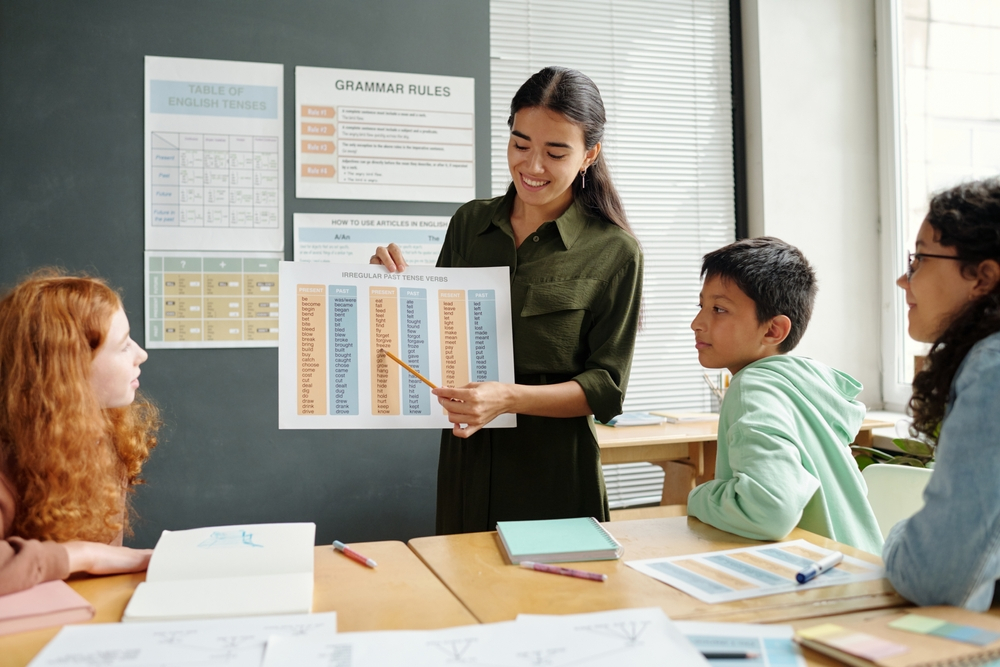
As our world becomes increasingly interconnected, American public schools reflect a corresponding rise in linguistic and cultural diversity. This is evident in the steady climb of English Language Learner (ELL) enrollments. ELL students come from homes where English isn’t the primary language, presenting unique educational challenges and opportunities.
Originally concentrated in traditional immigrant-receiving states like California, Texas, and Florida, ELL populations are now rising in many other regions, expanding the need for effective ELL strategies across the nation.
Looking toward the future, the National Education Association (NEA) Policy Brief makes it clear that the upward trend is likely to continue. The brief suggests that by 2025, the ELL student body is projected to make up an even larger share of the public school population. This forecast is built on factors like immigration patterns, birth rates among non-English-speaking families, and national educational initiatives aimed at inclusivity.
The Imperative for Enhanced ELL Instruction
Given these projections, the need for tailored and effective ELL instruction is not just an educational priority—it is an imperative that echoes the tenets of equity and inclusivity guiding modern pedagogy. Educational institutions must rise to meet the demands of this growing demographic by:
- Teacher Preparation: Investing in specialized training for teachers to address the linguistic and cultural needs of ELL students.
- Curriculum Development: Designing curricula that are both accessible to ELLs and that can facilitate their English proficiency without compromising content knowledge.
- Resource Allocation: Directing resources—including language learning technology, bilingual aids, and community outreach programs—to support ELLs both inside and outside the classroom.
- Assessment Practices: Developing and implementing assessment methods that accurately measure ELL students’ progress, considering factors beyond language proficiency such as content understanding and practical communication skills.
- Policy & Advocacy: Promoting policies at the local, state, and federal levels that recognize the unique needs of ELL students and allocate funding and support accordingly.
The anticipated growth in ELL populations posits a call for an educational system that is capable of evolving with its students. By investing in these areas, educators and policymakers will not only help ELL students to succeed academically but also integrate more fully into the broader educational community, laying the groundwork for a more diverse and dynamic future.

Understanding ELLs
The educational landscape is increasingly populated by students who are grappling to master English while also trying to succeed academically. English Language Learners (ELLs) bring a diverse array of backgrounds, experiences, and challenges to the classroom. A deeper exploration into their profiles, common challenges, and the impact of cultural diversity helps educators develop more effective instructional strategies.
The Profile of Today’s ELL Student
Today’s ELL student often navigates multiple identities. They may be recent immigrants, refugees, or born in the U.S. to non-English speaking families. While Spanish remains the most common language among ELLs, students come from a broad spectrum of linguistic backgrounds, including Chinese, Arabic, and Vietnamese, among others. It’s important to recognize that the ELL population is not homogenous:
- Age and Grade Level: ELL students enroll at various ages and academic levels, with differing degrees of prior education.
- Linguistic Diversity: They speak a wide range of languages and dialects, each with unique linguistic features that can influence English language acquisition.
- Socioeconomic Status: Many ELLs come from low-income households, where access to educational resources may be limited.
- Personal Circumstances: Some ELL students might be coping with trauma or adjustment to a new culture, which can affect their learning.
Understanding the profile, challenges, and cultural impact related to ELLs is an integral part of developing impactful educational strategies. By recognizing the individual and collective needs of ELL students, educators can create a supportive framework that facilitates not only language acquisition but also academic and social integration. As the ELL population continues to grow and diversify, the educational system’s responsiveness to these factors becomes even more crucial.
Effective Instructional Strategies
Educational strategies for English Language Learners (ELLs) must be well-informed, flexible, and multidimensional to cater to the diverse needs of students. The following are some in-depth strategies that can be integrated into lesson planning, reading practices, and interactive learning.
Adapting Lesson Plans for ELL Learners
Creating lesson plans that are meaningful for ELL students requires educators to consider the unique challenges these students face. Educators can start by:
- Providing Clear Objectives: Specify what students should learn and how they can apply the knowledge. This gives ELLs a clearer sense of direction and purpose in each lesson.
- Simplifying Instructions: Breaking down instructions into manageable steps can make lessons more understandable. This involves using simpler language and visual aids.
- Building Background Knowledge: Linking new information to ELLs’ existing knowledge helps them make connections and enhances comprehension.
- Integrating Language Objectives: Alongside content goals, include specific language skills to be addressed within the lesson, such as new vocabulary or grammar structures relevant to the topic.
- Utilizing Visuals and Manipulatives: ELLs benefit from materials that make the learning tangible, like images, graphs, or physical objects related to the lesson.
- Leveraging Technology: Digital tools can be particularly effective for ELLs, providing interactive experiences and personalized learning opportunities.
Interactive and Collaborative Learning for ELLs
Interactive and collaborative learning strategies are paramount to helping ELLs develop language skills through social interaction:
- Think-Pair-Share: This activity allows ELLs to formulate their thoughts individually, discuss them with a peer, and then share with the larger group, promoting language use in a supportive setting.
- Role-Playing: Acting out scenarios helps ELLs practice vocabulary and phrases in context, making language learning more relevant and engaging.
- Group Projects: Working collaboratively on projects can assist ELLs in developing communication skills and learning from peers, while also sharing their own perspectives.
- Language Games: Games that promote language development, such as Pictionary or charades, support vocabulary acquisition in a fun, low-pressure environment.
- Peer Review and Feedback: Structured peer review sessions can encourage constructive dialogue and mutual learning among students.
- Jigsaw Activities: Divide the class into groups, with each group responsible for mastering a topic or segment of a lesson, and then teaching it to their peers. This promotes both content mastery and language practice.
Adopting these instructional strategies can lead to a richer, more inclusive classroom experience for ELLs. By focusing on clarity, engagement, practical assistance, and communal learning, educators can create an environment where ELL students can thrive both linguistically and academically. Such strategies not only assist in language acquisition but also help in fostering a classroom culture that values diversity and collaborative learning.

Focusing on Reading Instruction
Practical Reading Strategies for ELL Learners
Reading is a critical skill pivotal for academic success, necessitating targeted strategies when teaching English Language Learners (ELLs). Initiating with pre-reading activities, educators can activate ELLs’ prior knowledge through discussions or activities that relate to the theme of the text, aiding in their understanding and engagement with the material. A vocabulary preview is also essential; introducing key vocabulary before the reading begins minimizes disruptions and enhances comprehension. Guided reading further supports ELLs by having an instructor read alongside them, regularly discussing the text to check for comprehension and posing predictive questions.
Additionally, teaching students to adopt different strategies for reading, depending on their purpose—whether it’s skimming for general ideas or scanning for specific information—enriches their reading skills. Finally, partner reading, by pairing ELLs with peers, facilitates learning and boosts confidence as they explore new texts together, making these strategies collectively beneficial for enhancing the reading skills of English Language Learners.
Teacher Training and Professional Development
Educators must be equipped with a holistic skillset tailored to the specific needs of English Language Learner (ELL) students. This section explores the essential skills for teaching ELL learners, the resources and training available for ELL educators, and the importance of continuous learning for those teaching ELL students.
Essential Skills for Teaching ELL Learners
To teach ELL students effectively, educators need to develop a range of skills. These include:
- Cultural Competency: Teachers must understand and respect the cultural backgrounds of ELL students to create an inclusive learning environment.
- Linguistic Knowledge: An understanding of the fundamental principles of language acquisition and the challenges that come with learning English as a second language is crucial.
- Instructional Strategies: Skills in differentiating instruction and adapting teaching methods to meet the various learning styles of ELL students are necessary.
- Assessment Techniques: Competence in designing and implementing assessments that can accurately measure ELL students’ learning progress without bias.
Resources and Training for ELL Educators
A wide array of resources and training programs are available to assist educators in their professional development, catering specifically to those involved in the education of English Language Learners (ELLs). Educational institutions frequently conduct workshops and seminars focusing on ELL instruction and cultural sensitivity, which are crucial for educators to effectively teach and connect with their students. Additionally, universities offer graduate-level courses and certificates in TESOL (Teaching English to Speakers of Other Languages), providing educators with the opportunity to gain in-depth knowledge and specialized skills in this field.
Mentorship programs also play a vital role, offering new teachers the chance to receive guidance and support from experienced mentors who have a successful track record of working with ELL populations.
To remain effective, educators of ELL students are encouraged to engage in continuous professional development, which involves staying updated with the latest research in ELL instruction and language acquisition theories to inform their teaching practices. Reflective practice is another essential component, where regular self-assessment of teaching methods and student outcomes can lead to the refinement of instructional approaches.
Engaging with local communities and ELL families offers educators valuable insights into the students’ backgrounds, enabling them to further personalize the learning experiences. Furthermore, joining professional organizations such as TESOL International Association can provide opportunities for networking and ongoing education, thus supporting educators in their commitment to continuous learning and improvement in the field of English language teaching.
Empowering Educators to Maximize ELL Learner Success
As educators grapple with the unique challenges presented by the increasing number of English Language Learners (ELL) in classrooms across the nation, the integration of innovative tools and strategies is paramount in shaping successful outcomes. Among such tools, ReadabilityTutor emerges as a valuable resource, offering a pathway to improve language skills and fostering a supportive learning environment for ELL students.
Harnessing the Power of ReadabilityTutor in ELL Education
- Personalized Learning Experience: ReadabilityTutor adapts to each student’s reading level, delivering a tailored experience that meets learners where they are. This personalized approach can enhance engagement, gradually build competence, and foster confidence in language skills.
- Real-Time Feedback and Support: With immediate corrective feedback on pronunciation and reading fluency, ReadabilityTutor allows ELL learners to practice and refine their English language skills in a supportive, error-forgiving space.
- Engagement with Rich, Diverse Content: ReadabilityTutor offers an extensive library of texts that cater to a variety of interests and cultural backgrounds, encouraging ELL students to connect with the material on a personal level while expanding their linguistic capabilities.
- Tracking Progress and Outcomes: Teachers can monitor students’ progress through intuitive dashboards, gaining insights into reading levels, time spent reading, and areas needing additional focus. This data-driven approach enables educators to guide their instructional strategies more effectively.
- Encouraging Independent Study Habits: The platform’s user-friendly nature promotes autonomous learning, allowing students to practice outside of traditional instructional time and instill positive study habits that contribute to lifelong learning.
As the tapestry of the student body continues to diversify, the role of educators in shaping the future of ELL students becomes increasingly significant. By leveraging dynamic resources such as ReadabilityTutor, teachers are equipped to deliver a more effective, engaging, and personalized learning experience. The thoughtful application of these resources, coupled with a commitment to professional growth, holds the promise of a transformative impact on the academic trajectory of ELL students. With a focus on innovation, adaptability, and a holistic understanding of student needs, educators can indeed pave the way for ELL learners to achieve not just linguistic proficiency but also academic excellence and personal empowerment.

 Español
Español